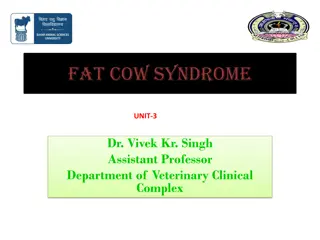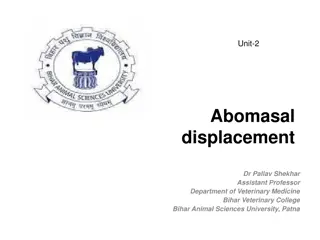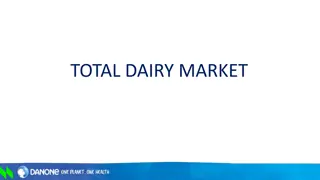Understanding Downer Cow Syndrome in Dairy Cattle
Downer Cow Syndrome (DCS) is a condition affecting dairy cows, characterized by prolonged recumbency despite treatment with calcium. It often occurs after milk fever and can lead to various complications. This article covers the etiology, clinical symptoms, prevention, and management strategies for DCS in dairy cattle.
Download Presentation

Please find below an Image/Link to download the presentation.
The content on the website is provided AS IS for your information and personal use only. It may not be sold, licensed, or shared on other websites without obtaining consent from the author. Download presentation by click this link. If you encounter any issues during the download, it is possible that the publisher has removed the file from their server.
E N D
Presentation Transcript
Downer Cow Syndrome(DCS) Dr. Bipin Kumar Assistant Professor Unit-3 Department of Veterinary Medicine Bihar Veterinary College, Patna (Bihar Animal Sciences University, Patna)
Downer cow syndrome Occurs after milk fever/hypocalcemia and clinically characterised by prolonged recumbency even after two successive treatment with calcium. Affected animals remain bright and alert but are unable to stand. This is frequently met in exotic and cross bred dairy cows. Most commonly occurs immediately after parturition and complication of milk fever condition. Two types 1.Creeper/alert downers 2.Non alert downers
Etiology Downer cows are unable to rise after two injections of calcium preparation. There is low phosphorus, potassium level. A low level of blood magnesium. Muscular injury due to too much confinement in the byre, obesity, over feeding during dry period and too much compression of limbs. Following PP a cow may develop DCS due to nerve injuries and over stretching of nerves or due to pressure on nerves while in recumbency. The damage of the heart muscle may be attributable to repeated dosing with calcium preparations in milk fever condition. Fat cow syndrome which predispose to downer condition.
Clinical symptoms Cow is unable to rise and remains in recumbent position. On stimulation the cow either makes little attempt or no attempt to rise . Cow remains bright and alert. Appetite, rumination, defecation and urination are usually normal. Temperature is usually normal but may turn towards sub-normal range in the terminal stage disease. The affected cow usually crawls around utilizing the forelimbs whereas hind limbs remain in flexed position. This type of stance is ascribed as "creeper cow" A downer cow which continues to remain down for more than 7 days ends fatally.
Prevention Comfortable bedding prior to calving and in advanced stage of pregnancy. Early detection and treatment of milk fever. Recumbent animals should be treated as soon as possible and not delayed for more than 1 hour. Cow should not be bred with a heavy bull.The weight of the bull should be within the weight bearing capacity of the cow. Otherwise there is risk of paralysis and fracture of hip bones. The cow should be bred with a bull as per its size as a big calf in a small cow will invite dystokia problem leading to calving paralysis. Cow should not be made over fatty through too much feeding during advance pregnancy. Cow should be made to stand within a short time following parturition.
Parentral Vitamin D3 should be given in milk fever prone cow during pregnancy. Low calcium and high phosphorus diet should be given to stimulate parathyroid gland and thus to avoid hypocalcaemia. If possible cow of a dairy farm should be brought under metabolic profile test to pinpoint the deficit and to make good use of it.
Control Recumbent animals should be treated as soon as possible and not delayed for more than 1 hour. Attempt should be made to roll the cow from side to side to minimize the extent of ischemic necrosis. Lift the cow and frequent turning should be made. Cow should be turned at least at 3 hours interval. Attempt should be made to lift the cow on its fore legs by using body slings. Hip lifters may be used for lift the downer animals. With the help of body slings, the animals should be allowed to stand for 20- 30 minutes and then lowered down. This should be repeated several times a day. Animal s both fore and hind limbs should be massaged two times per day.
Downer animals should be milked normally and the udder kept clean by washing with germicide soap before milking and post milking teat dips should be applied. Re-placement therapy with Calcium, Phosphorus, magnesium, Glucose containing preparations can be used parentrally by qualified veterinarian. Physiotherapy by adopting muscle massage may be made to restore muscle activity of the limbs.























